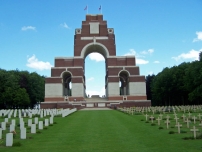| First Name: | Joseph Arthur | Last Name: | BLUSTIN | |
|---|---|---|---|---|
| Date of Death: | 09/09/1916 | Lived/Born In: | Dalston | |
| Rank: | Private | Unit: | London4 | |
| Memorial Site: | Thiepval Memorial, France | |||
Current Information:Born-Hoxton
The Battle of the Somme (July-November, 1916) By the beginning of September, 1916, the Battle of the Somme had been raging for two months. Thousands of men had already been killed or wounded or were simply missing, never to be seen again and and just a few square miles of the French countryside, all in the southern part of the battlefield, had been captured from the enemy. Mistakes had been made by the various commanders and would be continued to be made but there was no turning back as the British, Australians, South Africans, New Zealanders and Canadians carried on battering away at the German defences in the hope of a breakthrough, So it continued all the way through to November with nearly every battalion and division then in France being drawn into it at some stage. In the end the German trenches had been pushed back a few more miles along most of the line but the cost in lives had been staggering. When the battle drew to a close in November, 1916, British Army casualties numbered over 400,000, killed, wounded and missing. On 1st July, 1916, 56th (London) Division, which included 4th London of 168 Brigade, had been heavily involved during the opening day of the Battle of the Somme when they attacked the German defences at Gommecourt on the northern edge of the battlefield. They remained in that sector until they moved south, to where the battle was raging, at the beginning of September. After the capture of Guillemont on 3rd September, the next target for the British was the village on Ginchy which was successfully taken by 16th Division on 9th September with 56th Division supporting them to the south. The task of 168 Brigade on 9th September was to protect the right flank of 16th Division when they attacked Ginchy by assaulting the German defence line that ran between Leuze Wood and the Quadrilateral, a German strongpoint directly to the east of Ginchy. 12th London on the left and 4th London on the right moved to the attack at noon. 12th London met machine-gun fire from their left flank and from in front and only the right hand company made any progress but 4th London had greater success. However it did not start well. The German artillery laid down a heavy barrage on their assembly trenches in Leuze Wood at 4am but, despite the casualties, this did not prevent the battalion from moving forward forty five minutes later in six waves. The leading wave kept close to the creeping barrage and soon reached the first objective. At 5.25am they advanced again, through fierce shell and machine-gun fire which caused heavy losses, and within twenty minutes had reached and captured their final objective, an enemy trench south-east of the Quadrilateral. Here they consolidated and pushed forward patrols which established advanced posts overlooking the Morval-Leboeufs road. The success of 4th London was somewhat overshadowed by the many casualties the battalion suffered in achieving it. One of these was Joseph Blustin. |
||||
| « Back to Search Results | ||||
| If you think any of the information shown here is incorrect, Click Here to submit your amends and comments | ||||




